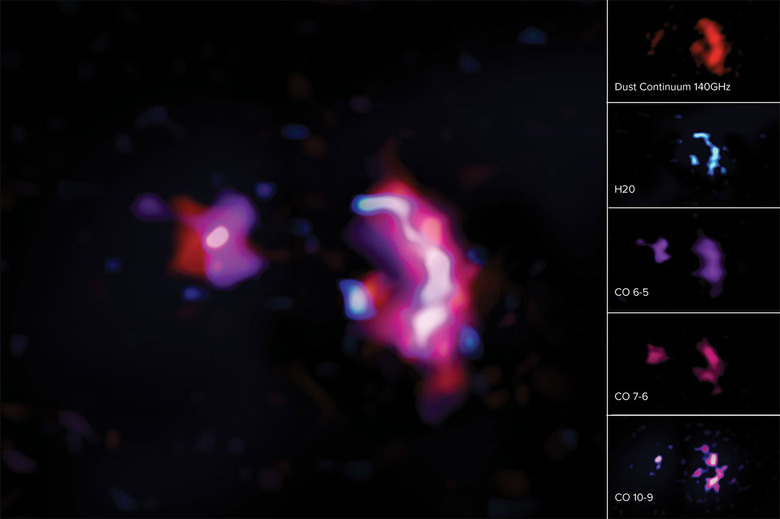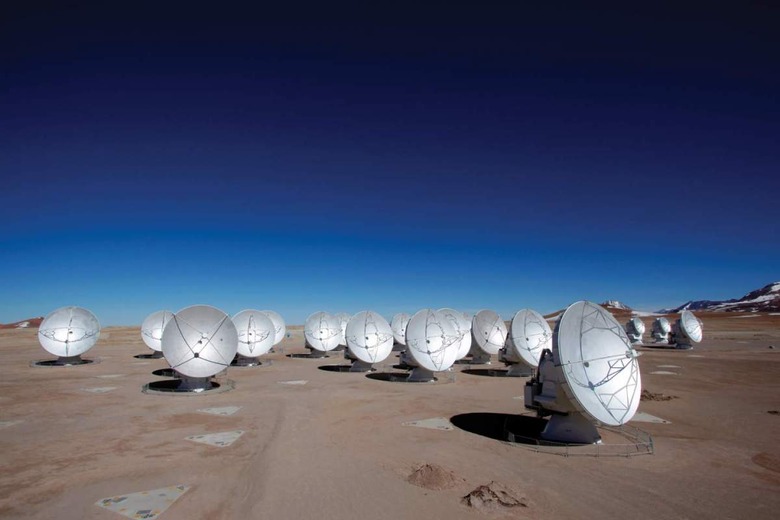Scientists Discover Signs Of Water In A Distant Galaxy
Scientists observing distant planets and galaxies are looking for indications that there might be planets orbiting in the habitable zone of stars. In addition to looking for those planets, they are also looking for indications that there may be elements required to support life as we know it, such as water. Astronomers using the Atacama Large Millimeter/submillimeter Array (ALMA) have been researching a massive galaxy that formed in the early universe called SPT0311-58.
During the research, scientists discovered signs of water and carbon monoxide in the galaxy. SPT0311-58 is 12.88 billion light-years away from Earth. With water and carbon monoxide detected in abundance, scientists believe the discovery confirms that the molecular universe was filled with those elements shortly after the molecules were created in stars. The research represents the most detailed study ever made into the molecular gas content of a galaxy from the early universe.
The discovery also represents the most distant detection of water in a star-forming galaxy. SPT0311-58 consists of two galaxies that were discovered in 2017, and both belong to the Epoch of Reionization. That epoch occurred when the universe was only 780 million years old, about five percent of its current age. This is the time when the first stars and galaxies were being born.

Evidence suggests the two galaxies are currently combining, and scientists believe they are rapidly forming stars, which is using up gas. They also believe the galaxies are evolving into massive elliptical galaxies like those seen in the Local Universe. To discover the water and carbon monoxide molecules, researchers utilized ALMA and focused on the larger of the two galaxies. Oxygen and carbon are first-generation elements, and in the molecular forms of carbon monoxide and water, they are required for life as we know it.
The larger galaxy is described as the most massive currently known at a high redshift, which is a time when the universe was very young. Interestingly, it has more gas and dust than most galaxies from the early universe providing scientists the opportunity to investigate the abundance of molecules and to learn how those molecules impact development in the early universe. Water is the third most abundant molecule in the universe after molecular hydrogen and carbon monoxide.

Past research of galaxies in the local and early universe indicates a correlation between water emission and far-infrared emission from dust. This is because dust absorbs ultraviolet radiation generated by the stars within a galaxy and then emits that absorbed ultraviolet radiation as far-infrared photons. Those photons cause excitation in water molecules, which creates the water emission scientists observed.
The ability to study galaxies from the early universe is important as it allows scientists to learn more about how the universe was born, grew, and evolved. Galaxies from the early universe form stars thousands of times faster than star formation occurs in the Milky Way. Scientists are far from finished with their study of SPT0311-58 and other galaxies from the early universe. One critical question that scientists are trying to answer is how galaxies in the early universe could gather so much dust and gas so quickly. More research is required to learn about the structural formation and evolution of the early universe.
ALMA is a very important tool operated in partnership between the European Organization for Astronomical Research in the Southern Hemisphere (ESO), the US National Science Foundation (NSF), and the National Institute of Natural Sciences (NINS) of Japan. ALMA is also operated with cooperation from the Republic of Chile with funding by the ESO from its member states.
